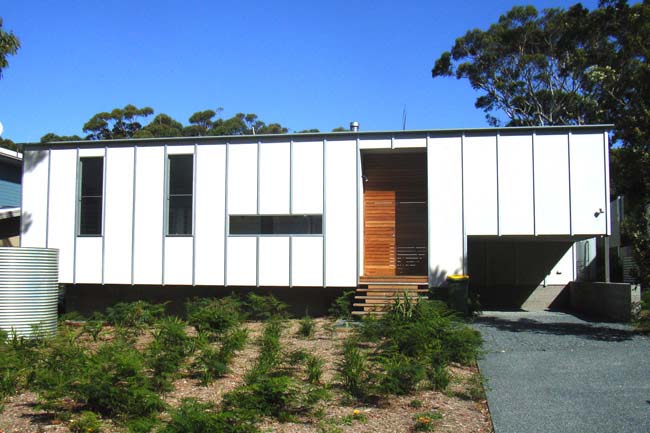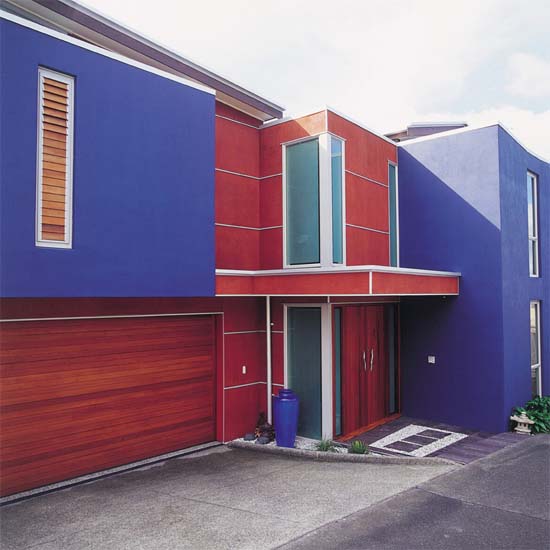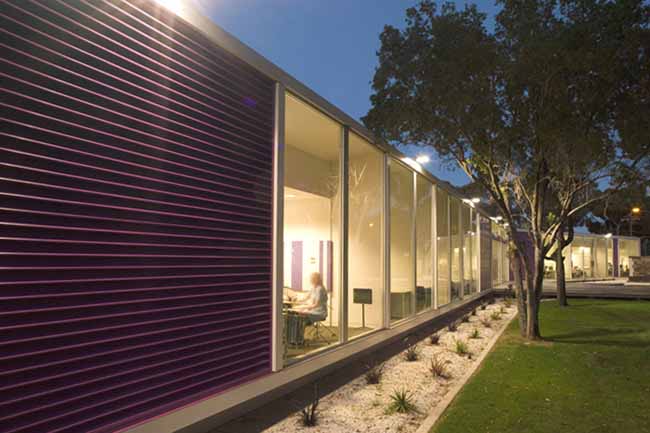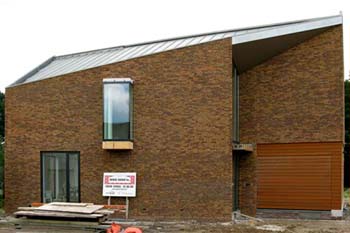Once the windows are in, the exterior walls are usually finished as soon as possible to make the house weather proof and secure.
The type of wall cladding chosen greatly affects the type of footings and framing you will need to choose. (That choice would have naturally been made early in the design process, and be included in the Specification document.)
While the optimum passive energy house design is a combination of an internal skin of brick or masonry, and an external skin of insulated sheet cladding, this is unfortunately rarely used.
In the past, double brick has been (rightly or wrongly) considered the best choice of wall construction and finish. If one could not afford double brick, then a brick veneer was considered the next best because it looked like double brick. In most cases, it doesn't, mainly because of the rest the house has often been made cheaply or without enough thought to the brick selection.
For urban houses the best choice of cladding often depends upon urban streetscape in which it sits. A rendered and painted finish may work best in a street full of similar houses on flat blocks. For regional houses, bush or beach locations, sloping blocks and other situations where the house must sit lightly on the land, there are a variety of interesting light weight materials that are appropriate. The choice is very much driven by what is sympathetic to the location.
Sheet and Board Claddings
Fibre cement sheets

Fibre cement cladding on beach house
Fibre cement cladding (http://www.bgc.com.au/fibrecement/s_18/18_nuline.html )is more common in regional areas due to its light weight. It is available in different thicknesses. Fibre cement cladding sheet joins need to be waterproofed with a pvc strip, timber batten, or shadow line join with a gasket or water strip underneath. See this article on Fibre Cement Cladding for more information.
There is also a selection of high density fibre cement in sheet panels and boards for both for vertical and horizontal installation. The wide horizontal boards are thicker than regular horizontal fibre cement cladding. They are generally overlaped, creating a visually dominate shadow on the next attached board. When these products are cut they have a very smooth, clean edge due to the high density compaction of the products. They are easily painted and visually work well with brick, timber and sheet metal cladding.
Plastic and Vinyl sheets
Low maintenance plastic cladding is available; however one has to ask why anyone would want to clad a house in plastic. It may well last forever but that makes it questionable. Plastic never breaks down, it only gets smaller. Is there not enough of this environmentally questionable material in the world? A better alternative are the more environmentally friendly vinyl weatherboard sheets.
Timber boards weatherboards
These can be made from natural timber, or a wood fibre composite. They come in many profiles and are recessed and rebated along their sides so they fit snugly together.
The natural timber can be stained or oiled but wood fibre composite products need to be painted. The boards can be fixed vertically or horizontally. When used vertically ensure sarking (waterproof membrane that sits between the external side of the stud wall and the cladding) and is undamaged before cladding.
A new addition to this area is the appealing Flatline, (http://www.timber.net.au/index.php/Flatline-Timber-Cladding-System.html) that is architecturally more interesting with narrower boards, deeper shadow lines, and better water sealing through deeper tongue and groove connections. Period style weather boards (http://www.healysbuilding.com.au/weatherboards.htm) are also available.
Marine and Exterior Plywoods sheets
Both exterior plywood (sold by Boral) and marine grade plywood can be used for exterior cladding. Both work well in contemporary designs or beach environments with steel, fibre cement and Colorbond.
Exterior plywood is generally a cross laminated exterior plywood that can be clear finished or used as a base for laminates. It is grown from plantation timber and has a smooth sanded or rough sawn finish. Often the same bonding resin is used in this plywood as in Marine plywood and therefore it can sustain heat, wet and cold conditions. However like all exterior timber, it needs to be recoated every two years otherwise it will discolour, mould and delaminate. The 12mm thick sheets are machined and are available rough-sawn, grooved and ship-lapped.
Also available are interesting veneer bonded sheets like ShadowClad They are slightly decorative sheets with a band-sawn surface (with a groove profile option) that can be purchased pre-primed if necessary.

Gunnersens' ShadowClad
Steel sheets

Stainless steel feature wall cladding
Flat, corrugated and profiled steel with corrosion resistant zinc/aluminium alloy coating like Zincalume or Colorbond are popular for their very Australian look, and their strength, durability, and lightness. They all work well with natural timber, brick and painted fibre cement. Many interesting light weight houses use combinations of these materials. Everyone of the mid tone colours in the Colorbond range blend in well with the colours of the Australian landscape.
For wall applications only the sheeting is attached by rubber backed hat-screws which, on corrugated sheets, are fastened in the valleys onto the stud wall frame. Colour matching hat-screws can be purchased or pressure pack cans of Colorbond paints can be used to paint these fittings the colour of the sheeting and to paint accessories and touch up scratches.
While Australians seem to love corrugated-iron/Colorbond, so do spiders who find the curved shapes make very good little spider houses. The end capping should therefore be well fitted. Rolls of black semi-circle foam strips are also available so the valleys at the end of the sheets can be sealed.
Weathered Steel
Best-known under the trademark Cor-Ten, this steel contains alloys that allow it to rust to a stable surface which removes the need for painting. This steel has been used mainly on sculpture and commercial architecture but is being considered by more adventurous designers for residential housing where it can look spectacular. See the St Andrews Beach House.
Cor-Ten steel is expensive. However it can be used well as a feature wall with precast concrete and other claddings like, fibre cement, corrugated iron and timber. It is also possible to have the exposed steel frame of a house fabricated in this steel, which again looks spectacular.
Brick Sheets

Creative blending slimline bricks
Brick Snaps are sheets of bricks that are cast on thin concrete slabs that can be vertically hung. With no mortar lines, brick sheets are an interesting consideration for contemporary houses, either as a complete cladding or a feature wall. Brick sheets look a little more "designed" than conventional brick work.
Stone Facade
Austral Bricks Lite-Stone is a light-weight natural stone facade, designed for simple installation by professional applicators or competent DIY-ers. It can be fixed with adhesive to most substrates. These stone facades come in a variety of styles, some looking more like solid stone than others. They can be quite effective as feature walls.
Terracotta Wall Tiles
This is a beautiful cladding. Terracade are terracotta wall tiles that are fixed to a channel system attached to a timber or steel stud wall. They look spectacular. Some tiles even have thermal insulation properties. They also work very well as a feature wall along side steel (and especially Cor-ten steel), stone and homogenous finishes like fibre cement. While it is one of the most expensive alternatives for wall cladding, it is also one of the most stylish.
Copper and Zinc claddings.
Copper and Zinc claddings, while expensive, look spectacular if used well. The copper cladding can be used as a feature wall with modern brick work, steel or timber.
See our blog on Funky Claddings for more information.
Brick and concrete block veneer

Beautifully blended brick veneer wall
This is the most common method of cladding as it is low maintenance, economical and a quick method of construction.
Many consider that the brick veneer housing developments are the scourge of the Australian residential landscape and the result of tasteless developers maximizing their profits by building similar houses with similar materials on the smallest block they can get away with. While there is a lot of truth to that, the right brick used on the right wall can look stunning.
Remember that veneer construction is just that, a non-loadbearing cladding and it is the stud interior wall that bears the roof load.
Brick Types
- Wire Cut Bricks. These bricks, with their familiar holes, are the cheapest and most common brick and are available in a range of textures and colours.
- Pressed Bricks. Dry pressed bricks are stronger than wire cut bricks, have a valley in their top face and a cork-like grainy appearance. Wet pressed bricks are similar but have a smoother, denser surface. The clean lines of wet pressed bricks make them well suited for contemporary houses.
Brick and concrete block veneer construction
The raft slab, strip footing or base brick wall needs to be wide enough to accommodate the brick width (and the cavity, usually at least 30mm.)
The brick wall is built up to the under side of the soffit lining which is normally 2100 mm above the finished floor level and is tied to the frame with galvanized steel brick ties. Flashing is required around all doors and windows, and over Lintels. It is generally angled steel but can be exposed concrete.
Subfloor vents are laid at intervals between the brick base walling and the bottom brick veneer skin. Zincalume steel or aluminium ant strip is laid to the inside of the base brick work. Vermin barriers of galvanized steel mesh are fasted to the bottom plate and built in to the mortar line. Bituminous sheeting or damp proof course is also laid to prevent rising damp. Finally the piers for the floor joists are built up from the footings inside the internal brick skin to the required level.
Ideally wall lengths and heights are based on multiples of the length, width & heights of a brick (usually 230mm x110mm) plus 10mm for mortar ie 240mm. Metric modular bricks and American bricks have different sizes. Tables http://www.boral.com.au/Images/common/clay_bricks_pavers/pdfs/1_101.pdf can be acquired from brick manufacturers.
All brick batches vary in colour and need to be mixed as they are laid. Bricklayers should make sure bricks are blended by working a minimum of four packs at the same time. The front of the building should never be built last when there are less bricks to select from. Deliveries should also overlap so bricklayers can mix the tail-end of one delivery with the next. It is the responsibility of the Builder or Owner Builder to inspect all deliveries for variation and breakages before acceptance.
Mortar is usually sand, cement or lime or a combination of both. The higher the amount of cement the stronger the mortar, however lime makes the mortar easier to work with. More lime is tempting to bricklayers because the mix goes off slower but this practice does not meet Australian bricklaying standards. The percentage of sand, cement and lime depends on the brick, because the strength of the mortar needs to be slightly less than the brick itself. Too much lime in a mortar mix makes the mortar very porus and can fall apart within a year or construction. Bricklayers should clean mortar smears on new bricks as they are laid
Brick veneer however, doesn't have to be the only cladding. It can be used very successfully as a feature wall with other cladding materials such as fibre cement and timber.
Solid Masonry
This includes double brick, block and natural stone and mud-brick. Limestone and sandstone can be easily cut to form well finished blocks, however single skin masonry walls need to be waterproofed. If water proofing is not possible then ample window or door overhangs need to be considered to prevent slow water penetration and moulding
Solid Masonry Construction
With double brick construction, only the inside walls are load bearing. Those walls are only as strong as the footings beneath them. The inner (structural) walls should be made of stronger pressed bricks although in most residential applications, strength is not an issue and extruded wire bricks are often used.
Windows and doors need steel or concrete lintels to support masonry above. In some cases the exterior brick is rendered, bagged or painted.
Solid masonry requires:
- Steel reinforced concrete strip footing under all walls
- Crawl space and ventilation openings in the base wall (below floor level) for raft slab construction
- Core filled with concrete to ground level
- Damp proofing coursing to stop rising damp creeping up walls
- Lintels (commonly angled steel) over all windows and doors
Masonry is generally built up in a uniform, overlapping brick, manner i.e. no sections are built higher than others. For those who need more information there are manuals (http://www.australbrick.com.au/national/brick_manual_2_brick_properties_and_bricklaying_practices.php)
Double brick homes have better thermal and acoustic insulation than most other construction. (Single skin inner structural wall and external insulated sheet cladding is the best.)
How to select bricks and mortar
There has been some very poorly designed brick housing developments built in Australia and much of it is the result of builders and developers making decisions based upon cost without any consideration to aesthetics.
While the natural appeal of brick is its low maintenance issue this apeal is forgotten when the brick start looking cheap and dated. Vast walls of contrasting blended bricks i.e. walls made of different coloured bricks, can look very busy and become tiresome. A wall made of common light brick with white mortar can also look also very monotonous. Similarly the busy looking highly textured brick and frit brick, (bricks that have glossy glass imbedded in them) can date and quickly look cheap and unattractive.
There are however a variety of bricks shapes and profiles that can be used to great effect. The art of good brick work is simplicity both in brick selection, and wall shape. Some of the best examples of great brick work are often seen in single fronted walls (ie walls with no corners), with no window sills, in "thinline" or European shaped bricks.
It seems that bricks are finely moving with the times because there are now some beautiful bricks on the market. (For example see: AustralBrick's website.)
The mortar used also affects the look of the brick. The most common mortar colour is mid-grey, often called "natural".
A mortar of a similar colour to the brick will disappear into the wall and throw emphasis to the brick face itself, especially if it's a highly textured brick. That works well as a feature wall in traditional environments but (depending upon the brick) can become tiresome if it is used over the entire house.
A mortar that is a contrasting colour to the brick will standout and introduce busy geometry to the wall. That works well in contemporary houses. Generally, a safe choice will be a smooth faced brick, with slight tonal variations, in medium/dark tones with light coloured mortar which contrasts with the colour of the brick.
The last consideration will be the brick joints i.e. how the mortar is finished between the bricks. It can be racked, flushed, ironed or struck. A raked mortar finish creates the most shadow line from sunlight along the horizontal mortar line. Ironed and struck joints also create more subtle shadow lines. A flush joint will have no shadow lines creating a flatter look. See Austral Bricks' website for more details.
